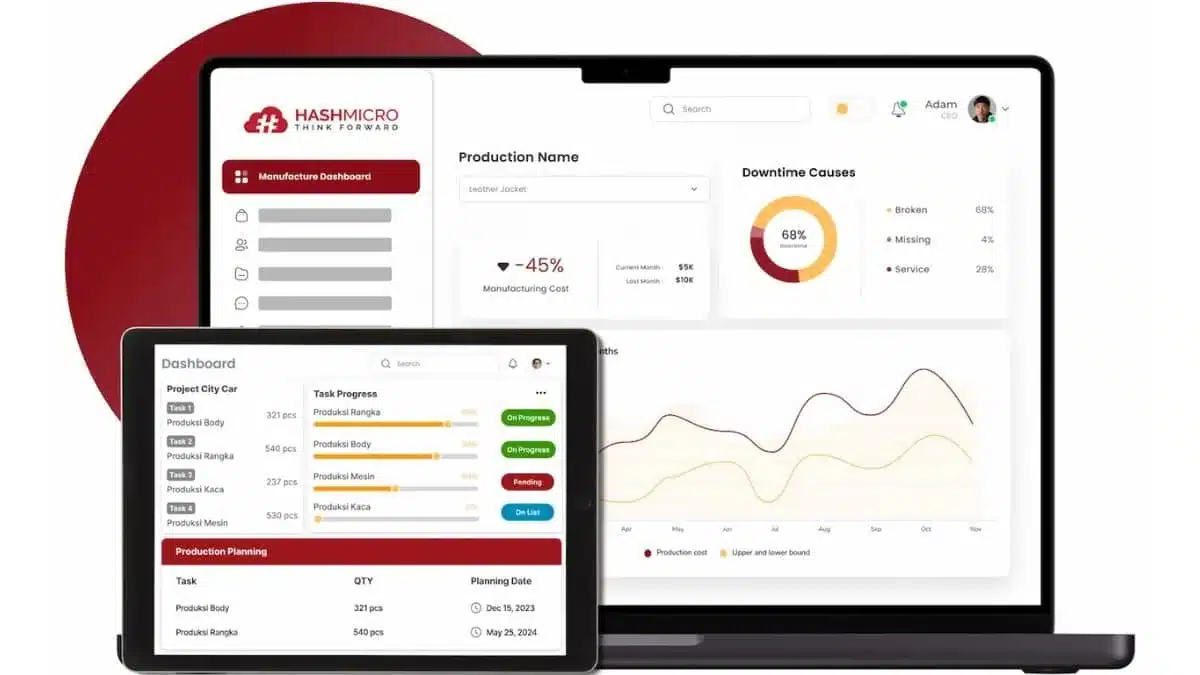As businesses strive for efficiency and competitiveness, managers face the daunting task of refining processes amidst constant change. Mastering Business Process Management (BPM) is essential, yet it comes with challenges.
Managers often encounter hurdles such as resistance to change, ambiguous goals, and insufficient testing frameworks within BPM initiatives. These challenges can impede progress and affect overall performance.
According to a report by Reuters, the Philippine information technology and business process management (IT-BPM) industry is projected to grow by 7% in 2024, reaching 1.82 million jobs and $38 billion in revenue.
Ang paglago na ito ay nagpapakita ng lumalaking kahalagahan ng epektibong BPM sa pagharap sa mga hamon ng industriya at paggamit ng mga oportunidad.
This article will explore these common BPM challenges and provide insights into software solutions that can help your organization overcome them effectively.
Table of Contents

Key Takeaways
|
What is Business Process Management (BPM)?
Business process management (BPM) is a structured approach to analyzing, optimizing, and automating business processes to align with organizational goals. It enhances efficiency by identifying inefficiencies and refining workflows, ensuring operations support key objectives like improving customer experience.
Unlike task or project management, BPM focuses on repeatable, end-to-end processes rather than isolated tasks or one-time projects. By continuously evaluating and refining processes, companies can reduce bottlenecks, enhance productivity, and more effectively adapt to changing business needs.
Many industries rely on business process management software to streamline workflows and improve decision-making. BPM helps organizations coordinate people, systems, and data from finance to healthcare, leading to increased efficiency and seamless digital transformation.
What are the Different Types of Business Process Management?

Business Process Management (BPM) is not a one-size-fits-all approach, because different businesses require different BPM solutions depending on their operational needs. Some processes rely heavily on automation, while others demand human intervention or structured workflows across multiple departments.
Understanding the distinct types of BPM helps organizations select the right approach to optimize efficiency and drive long-term success. Below, we explore the three main types of BPM and how they enhance business operations.
1. Integration-centric BPM
Integration-centric BPM focuses on automating workflows between enterprise systems with minimal human involvement. It connects various business applications, such as ERP and CRM. It uses APIs to ensure seamless data exchange.
This type of BPM meaningfully enhances efficiency by reducing manual intervention, preventing errors, and accelerating processes. Companies using integration-centric business process management software they will experience smoother, more consistent workflows across departments.
2. Human-centric BPM
Human-centric BPM is designed for processes that require active human participation, such as approvals, task assignments, and decision-making. It provides user-friendly interfaces, real-time tracking, and notifications to enhance collaboration and accountability.
This type of BPM is essential for managing workflows in HR, finance, and customer service, where human judgment is key. Organizations improve efficiency by optimizing human-driven business process examples without sacrificing control or flexibility.
3. Process-centric BPM
Process-centric BPM focuses on structuring, automating, and optimizing workflows across multiple departments. It ensures that business process management life cycle stages—such as planning, execution, and monitoring—are streamlined for better performance.
This type is particularly beneficial for industries with complex operations, such as supply chain management and healthcare. With process-centric BPM, companies enhance standardization, compliance, and operational efficiency.
Business Process Management Lifecycle

Implementing business process management (BPM) effectively requires a structured approach to ensure efficiency and continuous improvement. The BPM life cycle consists of five key stages that guide organizations in designing, implementing, and refining workflows.
Each step is crucial in identifying inefficiencies, optimizing processes, and improving overall business performance. Below, we explore the five essential steps of BPM and how they contribute to operational success:
- Design: A retail company implementing BPM for customer returns starts by mapping out the return process. The design includes defining return conditions, assigning roles to customer service and warehouse teams, and setting up an approval system for refunds or exchanges.
- Model: The company creates a visual model outlining each step after designing the workflow. Using BPM software, they simulate different scenarios—such as handling defective vs. non-defective returns—to identify bottlenecks, like delays in restocking items.
- Execute: Before rolling it out, the company runs a pilot in select stores. Employees follow the new return process, and managers gather feedback on processing times and system usability. Adjustments are made before full-scale implementation.
- Monitor: Once fully implemented, managers track key data points, such as the average time to process a return and customer satisfaction scores. If data shows refunds take too long, BPM tools help pinpoint whether delays happen at the approval or inventory update stage.
- Optimize: Based on monitoring results, the company automates repetitive tasks, such as refund approvals, under a certain amount. This reduces managers’ workload and speeds up processing, making the return experience smoother for both staff and customers.
What are the Benefits of Incorporating Business Process Management?

Implementing business process management (BPM) brings significant advantages by optimizing workflows and enhancing overall business operations. Integrating BPM into daily operations allows businesses to streamline tasks, reduce costs, and drive long-term success.
Below are the key benefits of adopting BPM in your organization.
1. Increased efficiency and cost savings
BPM enhances operational efficiency by eliminating redundancies, bottlenecks, and unnecessary workflow delays. By optimizing business processes, companies can complete tasks faster, allocate resources more effectively, and reduce waste.
Business process management software automates repetitive tasks, allowing employees to focus on higher-value activities. As a result, businesses achieve their goals faster while reducing operational costs.
2. Enhanced employee and customer experience
A well-structured BPM system improves employee productivity and customer satisfaction by simplifying workflows and reducing repetitive work. Employees can focus on strategic initiatives rather than administrative tasks with clear task assignments and automated approvals.
Business process management examples show that when employees work efficiently, customer service improves, leading to higher satisfaction rates. By making information easily accessible, BPM accelerates onboarding and improves workplace collaboration.
3. More scalable processes
As businesses grow, managing workflows across multiple teams and locations becomes more complex, making BPM essential for scalability. Business process management tools ensure consistency in process execution, providing a structured framework for expansion.
Automated workflows enable organizations to replicate successful business process examples across different regions without compromising efficiency. By integrating BPM, businesses can scale operations while maintaining quality and compliance.
4. Greater transparency and accountability
BPM improves visibility into business process management life cycle stages by clearly defining task ownership and responsibilities. Employees and managers can track progress in real-time, ensuring accountability at every workflow stage.
With business process automation, organizations foster better communication, reducing misunderstandings and inefficiencies. Greater transparency leads to improved decision-making and a more collaborative work environment.

5. Reduced dependency on development teams
Modern BPM solutions provide low-code and no-code automation features, enabling business users to create and modify workflows without extensive IT support. This reduces reliance on developers, allowing teams to implement process improvements quickly and efficiently.
BPM’s meaning extends beyond automation; it empowers employees with intuitive tools to manage business processes independently. Organizations can accelerate digital transformation by leveraging business management software while minimizing IT workload.
Business Process Management Use Cases

Business process management (BPM) is applied across various industries to enhance efficiency, automate workflows, and improve decision-making.
Below are some business process management examples showcasing its impact in different sectors:
- Content Distribution: Media companies like streaming platforms use BPM to automate content approval, rights management, and scheduling. For example, when a new movie is uploaded, BPM ensures it goes through licensing checks, quality reviews, and distribution approvals before publication.
- Customer Service: Call centers integrate BPM to manage customer queries efficiently. When a customer submits a complaint, BPM routes it to the right agent, tracks resolution progress, and sends automated follow-ups, ensuring faster response times and accountability.
- Finance: Businesses standardize purchase order approvals using BPM. If a department needs new equipment, BPM ensures the request is reviewed by finance, sent for manager approval, and processed for payment, reducing manual errors.
- Human Resources: HR teams use BPM for structured employee onboarding. When a new hire joins, BPM triggers automated emails, schedules orientation sessions, and assigns required training, ensuring a smooth and consistent onboarding experience.
- Banking and Loan Processing: Banks use BPM to speed up loan approvals. When an application is submitted, BPM verifies documents, checks credit scores, and notifies the applicant about missing details before forwarding it for final review.
- Order Fulfillment: E-commerce businesses rely on BPM for efficient order processing. When a customer places an order, BPM verifies stock availability, generates invoices, and triggers shipment tracking updates, ensuring seamless delivery.
Overcoming Key Challenges in Business Process Management

Implementing business process management (BPM) can transform an organization’s efficiency, agility, and collaboration. However, companies often face challenges that slow down adoption and limit the impact of BPM initiatives.
Below are the most common BPM challenges and how to overcome them effectively:
1. Resistance to change: Employees often resist BPM implementation due to fear of job loss or disruptions to familiar workflows. Clear communication, proper training, and involving stakeholders early in the process help ease concerns and encourage adoption.
2. Complexity in process mapping: Mapping business process examples across multiple departments can be overwhelming, especially in large organizations. Starting with core workflows and using business process management software with visual tools simplifies mapping and improves clarity.
3. Lack of executive support: BPM initiatives struggle to gain traction and secure resources without leadership buy-in. Demonstrating BPM’s ROI—such as cost reduction and efficiency improvements—helps align it with business objectives and gain executive sponsorship.
4. Inadequate process governance: Poor governance leads to business process management life cycle inconsistencies, making compliance and scaling difficult. Establishing clear ownership, standardized procedures, and regular audits ensures BPM remains structured and effective.
5. Technology integration issues: Integrating BPM with legacy systems can be challenging, slowing adoption and reducing effectiveness. Using flexible business process management software that supports API integrations enables seamless connectivity across enterprise applications.
6. Ongoing maintenance and optimization: BPM is not a one-time implementation—it requires continuous monitoring and refinement to stay effective. Leveraging analytics-driven BPM allows businesses to track performance, identify bottlenecks, and make data-driven improvements.
How do you Implement BPM in your Organization?

Successfully implementing business process management (BPM) requires careful planning and a structured approach. Rushing through BPM adoption can lead to inefficiencies, poor user adoption, and operational disruptions.
Organizations must ensure seamless integration with existing workflows to maximize BPM’s benefits while maintaining flexibility. Below are the essential steps to implement BPM effectively.
- Choose the Right BPM Platform: The right business process management software is crucial for smooth adoption and usability. Opt for a platform that balances powerful automation with user-friendly features, ensuring IT and business users can participate.
- Identify the correct process: Start with simple, low-risk business process examples, such as purchase approvals or expense reimbursements. Testing BPM on smaller workflows allows teams to adapt before scaling to more complex operations.
- Appoint a process owner: Assign a dedicated process owner responsible for overseeing the BPM implementation and ensuring its alignment with business goals. Clear ownership fosters accountability and keeps the process on track.
- Set clear benchmarks: Define measurable objectives, such as reducing turnaround times or minimizing manual errors. Establishing KPIs ensures the business process management life cycle drives continuous improvement.
- Map out your workflow: Before automating, sketch the workflow manually to identify inefficiencies and redundant steps. Collaborating with stakeholders helps refine the process for a more optimized execution.
- Involve key stakeholders: Successful BPM implementation requires collaboration between technical teams and business users. Engaging stakeholders early ensures that BPM meaningfully meets organizational needs and drives widespread adoption.
- Pilot the workflow: Test BPM in a controlled environment before rolling it out organization-wide. A pilot phase helps refine the system, train employees, and address potential bottlenecks.
- Stay flexible: Choose a BPM software that integrates with existing tools without requiring major IT overhauls. A flexible platform allows businesses to adapt processes without unnecessary complexity.
- Train your team: Educate employees on how BPM will improve their daily tasks and provide hands-on training. Well-trained users contribute to smoother implementation and long-term success.
- Measure and refine: Monitor key performance indicators (KPIs) to assess BPM’s impact. If workflows are not meeting expectations, refine and optimize processes to enhance efficiency.
Enhance Your Business Process Management with HashMicro ERP Software

HashMicro’s ERP Software offers a robust Business Process Management (BPM) solution to improve efficiency and accuracy in managing department workflows. One key feature is automated process tracking and real-time workflow optimization, seamlessly integrated into our BPM system to enhance business operations.
Experience the capabilities of HashMicro’s BPM solution through a free demo. Discover how automation streamlines business processes, reduces inefficiencies, and improves operational accuracy, ensuring better workflow management and faster decision-making.
Why choose HashMicro? Our BPM software automates critical tasks such as workflow monitoring, process optimization, and data-driven decision-making, minimizing manual errors and increasing overall productivity. Its seamless integration with other business modules provides a comprehensive solution for process automation and business efficiency.
Below are some of the key features of HashMicro’s BPM solution:
- Built-in BI (Business Intelligence): Advanced BI tools like Pivot, KPI Scorecard, and Dashboard Ninja provide real-time insights for more intelligent decision-making. Businesses can visualize key metrics instantly, ensuring data-driven strategies and improved efficiency.
- Sheet Management: A structured sheet management system organizes and tracks data effortlessly, simplifying document and workflow management. It streamlines collaboration across departments, ensuring easy access to accurate information.
- Fast Stock Opname: Automated inventory checks speed up stock-taking and updates, reducing errors and improving accuracy. With real-time stock visibility, businesses can optimize inventory levels and prevent shortages or overstocking.
- Smart Transaction Bookkeeping: Automated bookkeeping eliminates manual data entry, minimizing errors and ensuring financial records stay current. Businesses gain better control over financial data, improving budgeting, compliance, and decision-making.
- Real-time Reporting: Instant access to business reports allows companies to monitor performance in real-time. With accurate insights, businesses can make timely adjustments and stay ahead in a competitive market.
These capabilities enhance workflow visibility, reduce operational costs, and improve business efficiency. With HashMicro’s BPM solution, businesses can optimize workflows, maximize productivity, and achieve long-term operational success.
Conclusion
Business Process Management (BPM) helps organizations optimize workflows, improve efficiency, and align operations with business goals. Understanding BPM’s meaning, lifecycle, and key benefits allows companies to eliminate inefficiencies and enhance productivity.
However, implementing BPM can be challenging without the right tools. HashMicro’s ERP software offers a comprehensive BPM solution with automation, real-time monitoring, and seamless integration, making process management easier and more efficient.
Ready to optimize your business processes? Sign up for a free demo of HashMicro’s ERP software today and experience how automation can transform your operations!

FAQ About Business Process Management
-
What is the main purpose of BPM?
BPM enables organizations to halt ongoing processes, apply modifications, and restart them seamlessly. By adjusting, reusing, and customizing workflows, businesses gain greater flexibility and deeper insights into how process changes impact overall operations.
-
What does BPM mainly focus on?
BPM solutions are designed to define, execute, and monitor business processes effectively. They are particularly suited for long-running workflows that involve manual processing steps. These applications provide significant value by optimizing operations across various departments and industries.
-
What is the role of BPM?
Business Process Management (BPM) is a structured approach to enhancing the efficiency, effectiveness, and flexibility of organizational workflows. It encompasses the design, modeling, execution, monitoring, and continuous improvement of processes across different functions and levels.



































